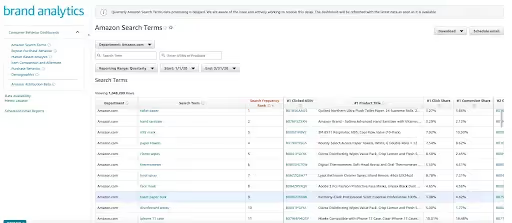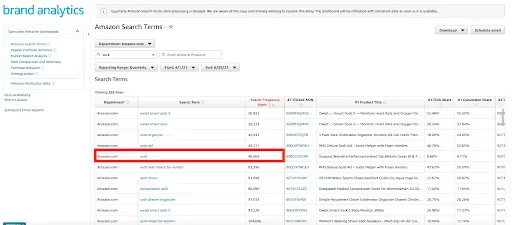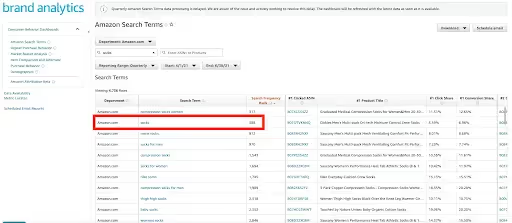Amazon SEO: Best Practices to Optimize Your Listing
Amazon success only comes if customers can find your product, and SEO can ensure your products are seen by the right people.
There are now 1.5 million active sellers on Amazon. With so much competition, how do you make sure potential customers are seeing your products? The answer is simple: Search engine optimization (SEO).
When you think of SEO, you may naturally think of big search engines like Google or Bing. But Amazon ads are clicked** 42% more often** than ads on Google. The conversion rate for Amazon ads is also 3.5 times higher than the rate for Google’s ads.

SEO has a huge impact on whether your product page will be found by customers on Amazon. But people search a little differently on Amazon compared to Google. Amazon’s algorithm is known as A9. Unlike Google, where people are performing a huge variety of searches (many of them informational), Amazon searches are mostly transactional.
Amazon is all about user intent: to buy. Customers locate products primarily by using a search query, and the keywords they use are matched against the information you provide about your product. Factors like your sales history, product availability, price, and text match will determine whether your product appears (and how high it appears) in the results.
A9 also factors in revenue per click and sales velocity (the number and size of sales in a given month). Amazon wants to facilitate sales, so rankings are based on the likelihood of a purchase. Unlike Google that ranks for information, Amazon ranks purely for conversion. Because the business model is selling products, they want to push the products that will sell the most. Understanding this difference between Amazon and Google search algorithms is essential for Amazon sellers.
Keyword research drives visibility
Any Amazon SEO strategy starts with keyword research. Keywords are the search terms that shoppers type into Amazon’s search bar to find your product. Using the right ones on your product page will make discovering the product easier for potential customers.
To identify the best keywords, you can use tools like Amazon’s Brand Analytics, which is available to registered brand owners. It has a keyword search tool that lets you look up different keywords to see how they’re ranking. For example, at the end of 2019 and before the COVID-19 pandemic, search terms for electronics like “airpods” and “nintendo switch” were at the top of the list:

Then once the pandemic hit in early 2020, search terms like “toilet paper,” “hand sanitizer,” and “n95 mask” rose to the to top:

Paying attention to search trends will help your SEO Amazon by informing you on the most searched keywords for your product.
You can also test different keyword variations. If you add a plural “s” to the search term “sock,” for example, it increases the search frequency rank from 48,569 to 388:


A simple keyword variation like this one can make all the difference in whether customers find your product.
Pattern partners also have access to our proprietary software Predict, which can help brands identify not only the keywords competitors are capitalizing on, but also predict which keywords the brand can rank for the quickest and which keywords can drive the most difference in revenue.
Whatever you do, don’t keyword stuff. To our knowledge, Amazon only scrapes a keyword on a product detail page once. So adding the same keyword multiple times won’t help your Amazon SEO. If anything, it will damage it.
What matters for Amazon SEO?
There are so many small factors that can affect your Amazon rankings. Afterall, Amazon just wants to show the best possible product to potential customers. That said, here are the most important things to get right when you’re optimizing SEO for Amazon:
Product titles
This is one of the most important elements of SEO for Amazon. You’ll want to include all relevant keywords for your product. Describe what your product is, what it does, your brand name, and any specific ingredients, materials, or colors. 4 to 6 keywords are all you need. Consider variations of your keywords as well. One way to do this is by logging out of Amazon and entering search terms in the search bar. Amazon will then give you suggestions which potential customers may be searching for. To make your product titles SEO Amazon ready, keep them relevant and natural, and be careful not to use competitor names or keyword stuff.
Bullet points
These are your product features, and they’re usually formatted as bullet points on the right side of your product page, next to your image. You have 250 characters to work with here, so highlight the top features you’d like to stand out to customers. Your bullet points should include crucial information like the dimensions of your product, along with the top benefits to convince them to buy. Include your relevant keywords, along with synonyms and variations of those keywords.
Product descriptions
The product description is your opportunity to use persuasive copy to sell your product to readers. However, it’s also a key aspect of Amazon SEO. The goal should be to attract and keep your readers attention, while naturally including keywords. Break your description up into easy-to-read paragraphs. Online shoppers tend to read in an F-shaped pattern when scanning product descriptions, so design your text with increasingly shorter lines:

Finally, consider adding A+ content to your product description. A+ content enhances your product page with custom-placed text and images. The visual appeal helps establish your brand image and instill trust in your product, which can increase customer loyalty and drive more clicks on your listing, an indirect signal to Amazon that your product is popular and will drive conversions when ranked.
Product images
Speaking of product images, high-quality photos are a must. Amazon recommends they be at least 1000x1000 pixels, so that they are large enough to zoom in on. Take sharp photos of your product with a high-resolution camera and be sure to get multiple angles. Online shoppers don’t get to handle the product or packaging before purchasing, so it’s important that you give them every opportunity to imagine it.
The main product image should accurately represent the product over a white background. Focus on the product only. Additional images can get a little more creative with different backgrounds and environments, but they must still pertain to the product. Don’t forget to include lifestyle imagery to help customers really visualize how the product will act in their everyday life. Consider including product videos or 360-degree view images, too, which allow customers to see the product from every angle. These offer customers an even greater visual detail before buying. Overall, better images lead to more conversions, a key aspect of Amazon SEO and good business.
Search filters
Another Amazon SEO strategy lies in search filters. Shoppers on the front-end can narrow their product search by selecting a dropdown category on the left of the search bar. After that, they can narrow their search even further by checking different filters on the left of the search results page.
Search filters span categories like delivery method, seller rating, color, brand, and condition. But Amazon only knows how to categorize your product if you provide the relevant information somewhere on the product page. Say you’re selling a red backpack, and you want it to be listed under red in the color filters. Then you need to mention the color red in the product description, so Amazon’s A9 algorithm can pick it up.
Search Filters are generally filled in through Masterfiles, or fields in an upload file that are on the backend of a product listing. In our experience, Search Filters are a commonly missed area for sellers to strengthen their listings to get indexed by Amazon’s system. Think from a shopper’s perspective and try to include any details that could be relevant to search filters. This way, you ensure your product comes up in advanced and not just basic searches.
Product Price
Amazon wants to feature the products that sell the most. If your product is too expensive, shoppers are less likely to buy it, but if it is too cheap shoppers can be wary of getting scammed. So the price of a product can greatly influence Amazon SEO. Look at products similar to yours on Amazon, check-in on any MAP policies, and set a competitive price. That way, your conversion rate will be higher and Amazon will rank your product page higher.
Customer reviews and ratings
Amazon values positive feedback. Notice how the products at the top of search listings always have several good reviews. The better the reviews, the higher a product ranks.
To get more reviews, ask customers to leave a review a few days after they receive their product. Amazon Seller Central has a “Request a Review” button to help streamline this process.
Once you start receiving feedback, improve your reviews by addressing the concerns and complaints that come in. Amazon rewards anything that improves the customer experience, so having several positive reviews is important for Amazon SEO.
Backend search terms
While keyword-stuffing will get you penalized by Amazon, there is a place you can add all of the remaining keywords that you couldn’t quite fit into your bullet points, description, and product title. This place is the backend search terms.
Backend search terms are generic single-word titles like tags. Customers don’t see these keywords, which means you can get creative and target related search terms, alternate spellings, and long-tail keywords. Think out of the box here to get your product in front of as many customers as possible. Here, your keyword research will come in handy. Use any semantically related terms that aren’t your main keyword. This way, you can rank for more keywords than just one. But remember that you are limited to 249 bytes worth of characters in backend search terms. The right set of backend search terms will greatly benefit your Amazon SEO.
Challenges of Amazon SEO
With so many factors that go into Amazon SEO, it is nearly impossible to attribute a dollar amount to any SEO Amazon optimization. While there are good practices, it all comes down to sales. The more a product sells, the higher Amazon will rank it.
What about new products? How do you optimize their product listings when they have few sales? The answer is by increasing traffic. Ecommerce is about traffic, conversion, and price. While Amazon SEO falls under conversion, you need traffic before you can drive conversions on Amazon. Do this by calling on brand differences and finding your target Amazon customer with content optimized for the right keywords. Increasing traffic will boost conversions and search ranking.
Once you see progress from your Amazon SEO efforts, make sure you maintain enough stock to keep up with the increased demand. You don’t want to drive more sales only to find you cannot fill all the orders. In that case, your brand will lose the buy box, and you will lose your rankings. Remember: Amazon wants the customer to have the smoothest experience possible, and out of stock products don’t contribute to that.
Amazon SEO is a long-term game that needs continual maintenance. The A9 algorithm is always subject to change, and Amazon is a highly competitive marketplace. You need to keep up with A9 and competitors to keep your products at the top of search rankings. Or have an SEO agency do the work for you. Whatever you do, don’t stop investing in your Amazon SEO strategy, or your search rankings will eventually sink.
Upgrade your Amazon SEO
Make your product page consumer focused, not machine-learning focused. Google’s search algorithm may value information and time on site, but Amazon is all about positive user experience that promotes the next sale.
Since its beginning, Amazon has introduced many product listing requirements to make sellers more mindful of consumers. Half the battle in Amazon SEO is simply complying with Amazon standards. After that, focus on increasing sales and your search ranking will rise.
Need help optimizing your Amazon product pages for SEO? Contact us today to see how Pattern’s marketplace experts can help you take your ecommerce business to the next level.


.jpg)





.jpg)

